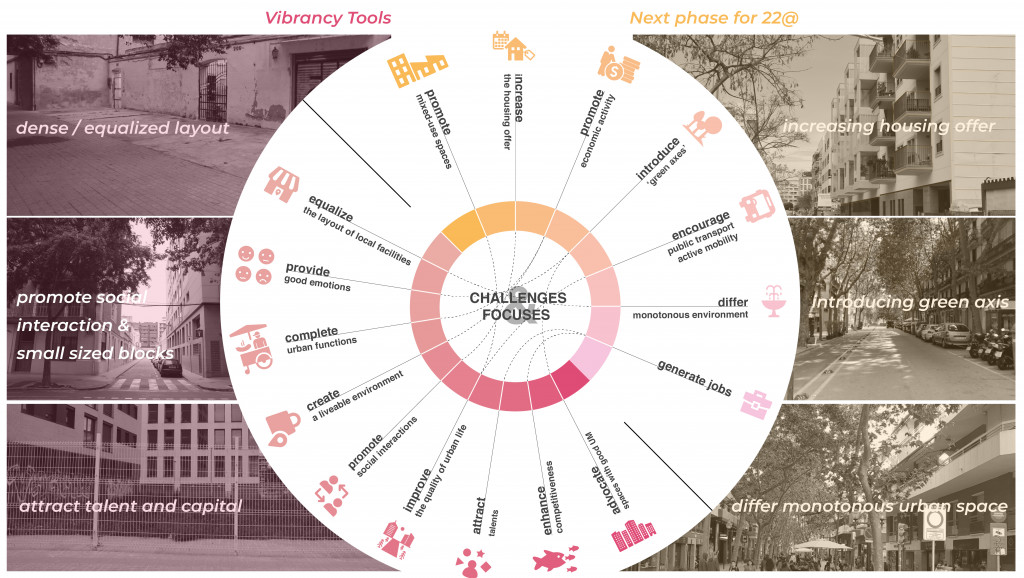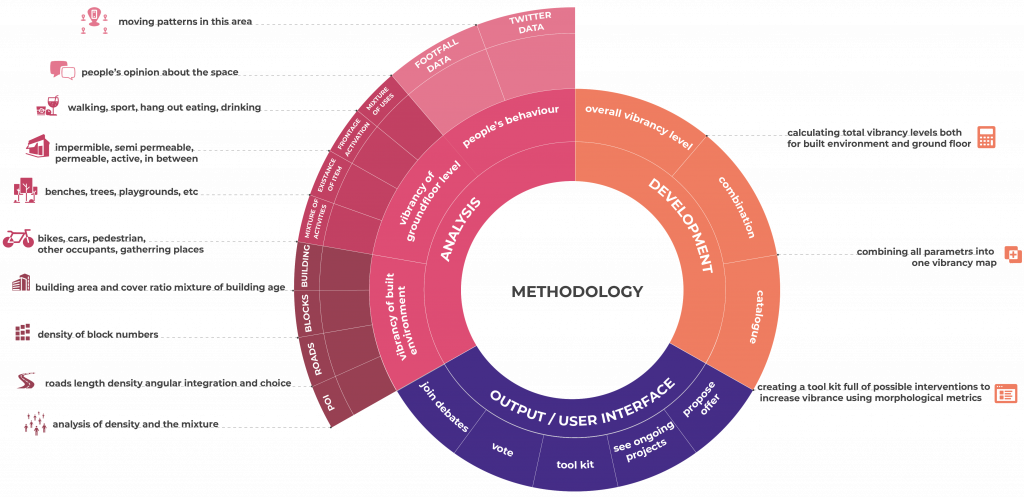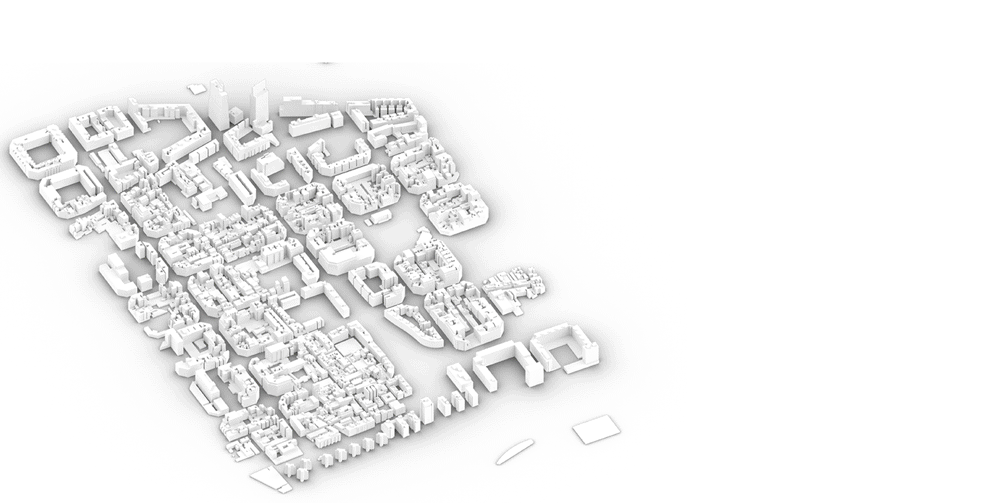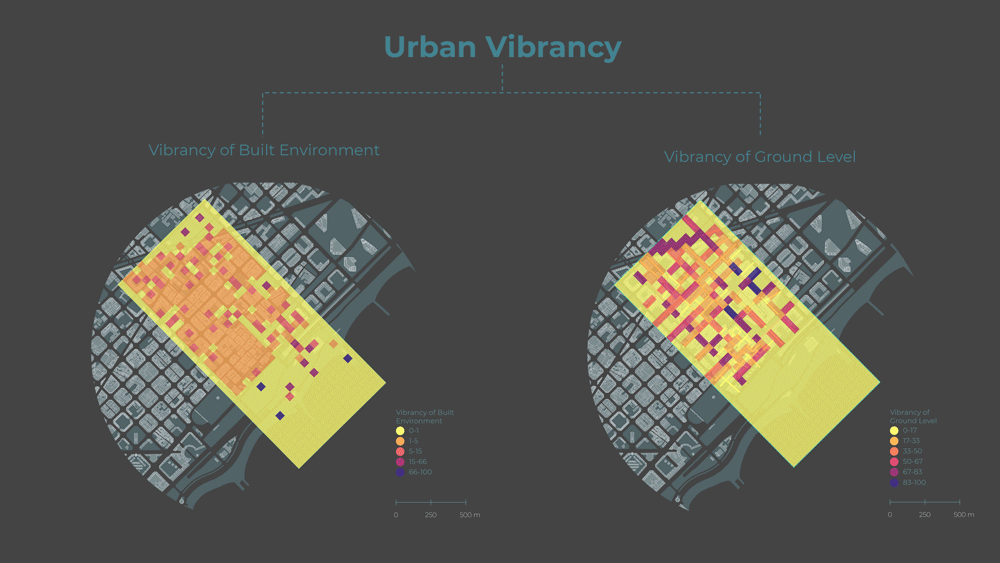Phoenix Project aims to promote urban vibrancy, by making use of morphological metrics. It mainly refers to updated plan decisions for 22@ District by providing all the layers of analysis, development and proposal for the radical change that awaits the area in the near future.
Phoenix PobleNou promises an inclusive platform to create a communication channel between those who propose changes and those who will experience them in an urban environment.
In a nutshell, it is for all future changemakers!
DEFINING THE CONCEPT

Urban vibrancy is an extensive field of study that comes up with different perspectives in different contexts. Jacobs first describe urban vibrancy as the “rich diversity of urban life” referring the interactions between residents and their production or living place [1]. Lynch defined it as the capability of an urban area to “support the vital functions, biological requirements and capabilities of human beings and protect the continuation of the species” [2]. Maas has taken the definition one step further and presented three basic components for urban vitality which are people, their activities and opportunities, and the environment where activities occur” [3]. Also, Montgomery contributed to the conceptualization of the term as an integrated representation of the “many and varied comings and goings, meetings and transactions” [4]
Considering the above-mentioned conceptualizations, urban vibrancy for us, is a study associated with activity intensity, the diversity of land-use configurations and the accessibility of a place. In other words, dense street networks, small and medium-sized blocks, and the diversification and intensification of building and land use can be considered as the identifiers of a vibrant area [5].
CHALLENGES & FOCUS

Being aware of the next phase for Barcelona’s 22@ innovation district reflects new challenges, we aimed to respond to this radical change, that awaits the area in the near future, with the tools suggested by the urban vibrancy. Developed nearly 20 years ago, the district plan has been updated to respond today’s challenges. Some of the main conclusions from the updated plan, which we will also highlight in our study, are as follows [6]:
Green streets: According to the climate adaptation measures, the plan proposes a third of vertical and horizontal streets becoming a network of green axes.
Social housing: Under the new plan, 30 percent of the new developed area of 22@ will be dedicated to housing compared to 10 percent in 2000.
New sectors: In the original plan, new companies setting up there had to be tech focused. This has been expanded to businesses in the green, circular economy, social and smart manufacturing sectors that will promote mixed-use spaces
METHODOLOGY

As per the methodology, we followed 3 basic steps beginning from analysis, development, and proposal which is an interface as an output. For the analysis, first we preface with vibrancy of built environment consisting of 4 main categories: buildings, blocks, roads and point of interests. Under each category, we came up with separate layers of analysis such as building area/cover ratio, entropy calculations for building ages, block numbers, road length, angular integration and choice, entropy calculations for different types of POIs (residential, commercial & services, transportation, education, outdoor and recreation) and density maps for each category.
Secondly, we analysed the vibrancy of ground level with the help of site observations on mixture of activities, existence of items, frontage activeness and mixture of uses. Dividing the road matrix into x and y axis and assigning a value to each segment in between the intersections, where the maximum vibrancy value is 100. In this way we were able to analyse the variation of vibrancy through sections and understand how they vary in relation to the morphological parameters as the building height and the road size. And lastly analysing people’s behaviour, we were able to understand the not only the morphological aspects of the space but also the movement and accumulation within the space.

Vibrancy levels on the ground level
For the development, we combined the density and entropy maps under 2 categories and then developed total vibrancy map showing the high, medium, and low vibrancy levels in the study area which help us, in the next step, to propose relevant interventions.

Total vibrancy levels in the area
USER INTERFACE
As our proposal, Phoenix, promises an inclusive platform both for technical team members who are supposed to explore all layers of analysis and propose possible interventions promoting urban vibrancy. On the other hand, community members are able to follow ongoing projects, vote for, or highlight the proposals suggested by technical teams. Community members also have a chance to join community debates to learn more about the details related to the proposals.
Logging in as technical team member one can explore the total vibrancy levels in our study area with all layers of analysis mentioned before. It also allows us to select a specific are to see the contribution of either vibrancy of built environment or vibrancy of ground level to the overall vibrancy within the selected area. There is also an option to check the projects which are already started in a specific area. By turning on each layer of analysis, technical team members have an option to further explore multiple maps separately. Once the layers are analysed and those having rough edges selected, then we can continue with the catalogue of interventions that are affecting the layers that have been selected before.
We imagine this catalogue consisting of proposals made and uploaded by various technical teams. In the catalogue every proposal is categorized based on the metrics that it affects regarding urban vibrancy. So, after analysing Urban Vibrancy in one area, we can then identify the metrics that are lagging behind, and through the filters we can cluster the proposals that are affecting these specific metrics. After identifying the proposals that are suiting our project, we can select them and visualize the material that each team has uploaded in the toolkit.
In the visualization panel we can see the proposals as well as the metrics they are affecting along with our filters. Since ,on one hand we are talking about morphological metrics, the proposals are for sure based on the morphology of the neighbourhoods and the infrastructure. However, since we are also talking about ground level metrics such as presence of people or how permeable and active the facades are, we understand that the proposals are of course affecting the way people experience space. Besides that, we have 4 more options: First, the myPhoenix tab where you can save the proposals that you like or want to explore more. Second, you can locate the proposal so that it can appear in the community member section for them to vote it, and of course you can access the voting results of each proposal. Finally, you can download the documentation for more exploration.
We believe that the re-evaluation of our decisions is very important. So, after selecting your proposals and adding them to myPhoenix feature you can recalculate the total Urban Vibrancy levels that will occur if you implement the chosen proposals. Finally, you will be able to compare the two results in order to understand how the proposals are affecting the selected area.
The interface also allows community members to interact actively and participate in the process. Once they login, they will see the overall vibrancy map with ongoing projects where they can check for project details and timelines in their neighbourhoods. In the catalogue, they will see all possible proposals suggested by the technical teams, as explained before. There is also a possibility to highlight any proposal, meaning that a community member wants this to be implemented in his neighbourhood. Or they can leave a comment on the suggested proposals.
In the next step, community members will be able to see the projects that are having a specific location. Since not all the proposals achieve the level of localization. Here they can see list of interventions with their locations and visualisations. Furthermore, all these proposals will be open to debate and vote by the community members for active participation.
CONCLUSION
As we know, the city is not only what we can see but also what we can not. Phoenix starts from the morphology of PobleNou to calculate the Vibrancy of Space based on some metrics, but our goal is to create a more dynamic, data-driven and participatory toolkit that will link the future change makers to the community.
To explore user interface more, please visit our trial run for Phoenix Platform: Phoenix Platform
References:
- Jacobs, J. The Death and Life of Great American Cities; Random House: New York, NY, USA, 1961.
- Lynch, K. Good City Form; MIT Press: Cambridge, MA, USA, 1984.
- Maas, P.R. Towards a Theory of Urban Vitality; University of British Columbia: Vancouver, BC, Canada, 1984
- Montgomery, J. Making a city: Urbanity, vitality and urban design. J. Urban Des. 1998, 3, 93–116.
- Li, S., Wu, C., Lin, Y., Li, Z., & Du, Q. (2020). Urban Morphology Promotes Urban Vibrancy from the Spatiotemporal and Synergetic Perspectives: A Case Study Using Multisource Data in Shenzhen, China. Sustainability, 12(12), 4829
- Wray, S. (2020, October 6). Next phase for Barcelona’s 22@ innovation district reflects new challenges. Cities Today – Connecting the world’s urban leaders.
Phoenix Poblenou is a project of IAAC, Institute for Advanced Architecture of Catalonia developed at Master in City & Technology in 2020/21 by students: Arina Novikova, Kshama Patil, Simone Grasso, Sinay Coskun and Stephania Kousoula and faculty: Angelos Chronis, Iacopo Neri, Mahsa Nikoufar and Androniki Pappa